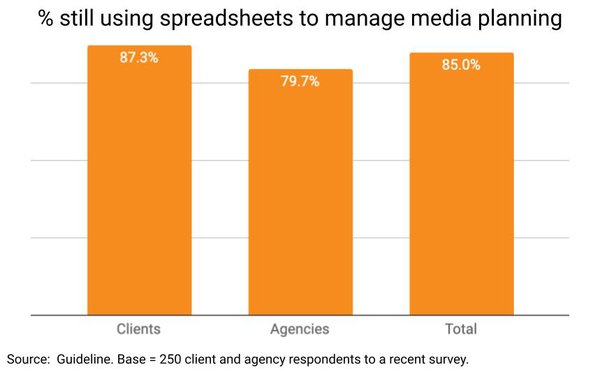
For those who fear advanced automation and AI technologies
will soon replace the manual functions of media planning, new research indicates most advertisers and agencies still are pretty old school when it comes to the process, relying on spreadsheets -- not
even dashboards.
Eighty-five percent of 250 client and agency execs responsible for managing media planning still use either Microsoft Excel files or Google Sheets, according to findings of an
April survey released this week by Guideline, the parent of Standard Media Index, SQAD, Lumina and other planning and buying tools.
Interestingly, clients are even more reliant on spreadsheets
to manage media plans than agencies, according to the findings (see above).
Not surprisingly, Guideline is using the findings (see others below) to announce the launch of its own new centralized
planning management solution, Guideline Planning, which it says enables media planners to centralize the process of planning, allocating, visualizing, analyzing and optimizing media buys vis more than
20 API integrations with key data sources. See graphic representation below.
advertisement
advertisement

Meanwhile, other key findings from Guideline's survey include:
- Marketers depend on several data sources to inform their media planning. 54% of brand and agency marketers utilize 3-5 data sources to inform their planning, while 20% use 1-2, and
nearly 18% utilize 6-9.
- There is a disconnect between insights and optimization. While 28% of respondents indicated they receive data daily to help optimize ad spend
throughout the year, many marketers still optimize plans on a monthly basis. In fact, nearly 26% (25.7%) stated they alter and/or optimize ad spend allocation monthly – with just over 12%
(12.4%) optimizing daily. This disconnect creates a lag in optimal allocation.
- Planned ad spend depends on more than previous investments. When deciding where to
allocate ad spend while making yearly plans, over 48% indicated they base their decisions on channel or medium successes from the previous year; nearly 31% indicated “based largely on spend
allocations from the previous year;” and nearly 21% indicated “based on conversations in-market.” While the planning process has historically remained an annual occurrence,
today’s media landscape requires a more frequent cadence when it comes to the optimization of planned investments.